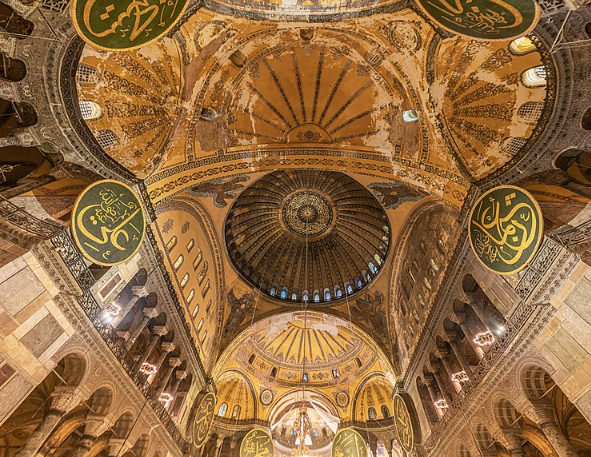Hagia Sophia: A 1600-Year History Of Survival

Table of Contents
From Byzantine Cathedral to Ottoman Mosque: A Transformation Through Time
The Byzantine Era (532-1453 AD): A Marvel of Engineering and Art
The Hagia Sophia's story begins in the heart of the Byzantine Empire. Commissioned by Emperor Justinian I and built between 532 and 537 AD, it served as the center of the Eastern Roman world, a testament to the empire's power and wealth. The architectural innovations of Anthemius of Tralles and Isidore of Miletus were groundbreaking. Their use of pendentives, ingenious structures that allowed a massive dome to rest on a square base, was a revolutionary feat of Hagia Sophia architecture. This immense dome, measuring 31 meters in diameter, dominated the skyline and symbolized the Byzantine Empire’s ambition.
The interior was equally breathtaking, adorned with lavish Byzantine mosaics that depicted religious scenes and imperial portraits. These Byzantine mosaics are considered masterpieces of Byzantine art, showcasing the empire’s artistic prowess and religious devotion. The Hagia Sophia's construction involved advanced techniques for dome construction, demonstrating the high level of engineering skill during this era.
- Key features: Immense dome, innovative pendentives, stunning Byzantine mosaics.
- Architects: Anthemius of Tralles and Isidore of Miletus.
- Significant events: The Nika riots of 532 AD, numerous restorations throughout the Byzantine period.
The Ottoman Era (1453-1935 AD): Adaptation and Renewal
The Ottoman conquest of Constantinople in 1453 marked a turning point in the Hagia Sophia's history. Converted into a mosque, it underwent significant modifications to reflect Islamic architectural traditions. Four minarets, slender towers from which the call to prayer is made, were added, along with a mihrab (a niche indicating the direction of Mecca) and a mimbar (a pulpit). These additions, while altering the building's appearance, didn't diminish its grandeur. The Ottoman sultans invested in its upkeep, overseeing various renovations and adding elements of Ottoman architecture. This blend showcases the fascinating interplay between Byzantine and Ottoman influences within the Hagia Sophia. Preservation and adaptation were key aspects of its maintenance under Ottoman rule.
- Key changes: Addition of minarets, mihrab, and mimbar.
- Prominent sultans: Mehmed II, Suleiman the Magnificent (who oversaw significant renovations).
The Republican Era (1935-Present): Museum and Beyond
In 1935, Mustafa Kemal Atatürk, the founder of the Republic of Turkey, transformed the Hagia Sophia into a museum, opening its doors to visitors from around the world. This decision reflected a commitment to secularism and the preservation of Turkey's rich cultural heritage. The 20th and 21st centuries have seen significant restoration efforts focused on preserving the Hagia Sophia's intricate mosaics and architectural elements. As a UNESCO World Heritage Site and a major Istanbul tourism attraction, it continues to draw millions of visitors each year.
- Key events since 1935: Conversion to a museum, various restoration projects.
- Current status: Following its 2020 reconversion to a mosque, its future role continues to be a subject of international discussion and debate.
Hagia Sophia's Enduring Legacy: A Symbol of Cultural Exchange and Resilience
The Hagia Sophia’s enduring legacy lies in its remarkable ability to adapt and survive through centuries of change. It stands as a potent symbol of cultural exchange, showcasing the blending of Byzantine and Ottoman architectural styles and reflecting the diverse religious and political landscapes it has witnessed. Its continuous adaptation highlights human creativity and perseverance in the face of adversity. The building transcends mere architectural significance; it's a powerful testament to the continuous evolution of human history and cultural heritage. Its impact on art, architecture, and religion is immeasurable and its continued relevance speaks to its enduring power as a symbol of cultural exchange and religious tolerance.
- Impact: Profound influence on architecture, art, and religious practices across centuries.
- Continued relevance: A living symbol of cultural exchange and a reminder of the interconnectedness of civilizations.
Conclusion:
The Hagia Sophia's 1600-year journey is a remarkable testament to human ingenuity, resilience, and the power of architectural marvels. From its beginnings as a Byzantine cathedral to its current status (and past role as a museum), this iconic landmark has continuously adapted to changing political and religious contexts, reflecting the rich tapestry of history. Its blend of Byzantine and Ottoman architectural styles symbolizes cultural exchange and underscores its importance as a global symbol of architectural history. Explore the enduring legacy of the Hagia Sophia and discover the fascinating story behind this iconic landmark. Plan your visit to Istanbul and witness the magnificence of this architectural wonder for yourself! Learn more about its history [link to relevant resource, e.g., official website or a reputable historical site].

Featured Posts
-
 Dismissing Valuation Concerns Bof As Argument For A Bullish Stock Market
Apr 29, 2025
Dismissing Valuation Concerns Bof As Argument For A Bullish Stock Market
Apr 29, 2025 -
 Dwindling Resources In Gaza Calls To End Israels Aid Ban Intensify
Apr 29, 2025
Dwindling Resources In Gaza Calls To End Israels Aid Ban Intensify
Apr 29, 2025 -
 Why Kentucky Storm Damage Assessments Are Delayed
Apr 29, 2025
Why Kentucky Storm Damage Assessments Are Delayed
Apr 29, 2025 -
 Two Georgia Deputies Shot During Traffic Stop One Fatality
Apr 29, 2025
Two Georgia Deputies Shot During Traffic Stop One Fatality
Apr 29, 2025 -
 Analysis Of Jeff Goldblum And The Mildred Snitzer Orchestras I Dont Know Why I Just Do Feat Ariana Grande
Apr 29, 2025
Analysis Of Jeff Goldblum And The Mildred Snitzer Orchestras I Dont Know Why I Just Do Feat Ariana Grande
Apr 29, 2025
Latest Posts
-
 Capital Summertime Ball 2025 Your Complete Ticket Buying Guide
Apr 29, 2025
Capital Summertime Ball 2025 Your Complete Ticket Buying Guide
Apr 29, 2025 -
 Securing Capital Summertime Ball 2025 Tickets Tips And Tricks
Apr 29, 2025
Securing Capital Summertime Ball 2025 Tickets Tips And Tricks
Apr 29, 2025 -
 Fhis Forskning Pa Adhd Medisin Og Akademisk Suksess
Apr 29, 2025
Fhis Forskning Pa Adhd Medisin Og Akademisk Suksess
Apr 29, 2025 -
 Capital Summertime Ball 2025 Tickets A Step By Step Guide
Apr 29, 2025
Capital Summertime Ball 2025 Tickets A Step By Step Guide
Apr 29, 2025 -
 How To Get Capital Summertime Ball 2025 Tickets Your Guide
Apr 29, 2025
How To Get Capital Summertime Ball 2025 Tickets Your Guide
Apr 29, 2025
